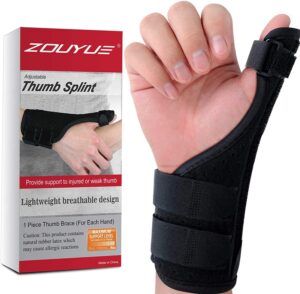Thumb pain before or after having a baby is a lot more common than you might think. It even has it’s own name, it’s called De Quervain’s syndrome or De Quervain’s tenosynovitis. The pain comes from a couple of tendons at the base of your thumb (over the side of your wrist) that become inflamed. These tendons are supposed to get on well together and move in sync with the thumb and wrist but when this movement is either restricted or increased, they can become irritated and stop moving properly with one another. This causes a ‘rubbing’ effect where they sit and the tendons become painful, swollen, lumpy and / or weak over time.
Why does being pregnant or becoming a mum have anything to do with my thumb? (I hear you say)!
Well, firstly, during pregnancy, (I’m sure you’re aware) you gain lots of extra fluid in your body, this extra fluid and change in hormones can cause swelling and compression, over the tendons, where they lie and then when they try to move, there is friction (that wasn’t there before). This can also be associated with carpal tunnel syndrome (numbness in the hand and fingers due to compression over the nerves entering the wrists).

Secondly, once the baby is at home with you and the fluids in your body have gone back to a normal range, you are deep into the world of sleepless nights, changing nappies, rocking baby, picking him / her up and doing whatever you can to stop they crying! This change in lifestyle puts a big strain on our tendons that they didn’t have before. In fact, a study has shown that, on average, we lift our babies 90 times a day, when you add this together, it turns out that you are lifting almost a ton on a daily basis. That is a BIG load to add on to those poor, unsuspecting tendons.
So, when the tendons are injured, what will that mean for me? What will I feel or see?
There will likely be pain in the thumb (at the section that meets your wrist) but the pain can also be in the wrist itself and the forearm (the tendon becomes a muscle that travels across the arm). There is likely to be pain when you poke and prod around the base of the thumb. You might see or feel some swelling also in this area and it might look red or feel hot to touch. Some people with De Quervain’s also describe a clicking or a snapping sound at the wrist or a grinding with wrist or thumb movements. It can be quite debilitating having De Quervain’s syndrome, especially with a new baby. It’s only once you have pain in your thumb that you realise just how much you use it.
The big question……How do I get rid of the flippin’ thing?
We, at Pain in the Bump, are all about the research. If research doesn’t back it, then we don’t recommend it. Having said that one thing that we need to mention that is likely going to help (because it probably caused it in the first place) is:
Rest – of course we’re not suggesting that you just stop picking your baby up to give your thumb a rest, that’s mean! However, you can rest your thumb, whist still picking your baby up by changing your grip! You need to stop using the ‘pincer grip’ position (as long as it feels safe to do so) and keep your thumb next to your fingers in a ‘scoop grip’ position.

Above is an example of what a pincer grip looks like, the thumb is being used to grip the baby under the arms and helping to support the weight, but is being worked quite hard as the tendons are lifting the thumb up at the same time.
You could try carrying your baby in a ‘chair’ position to allow you to keep your thumb next to your fingers, in more of a rested position.

Alternatively, scoop them up if they’re in a lying position, supporting their shoulders, head and back on your palms an forearms.

I would also consider using a sling a little more, even for simple tasks around the house, just to give your hands (and back) a little more rest. You’ll find ways that suit you and that work best for you in various situations, but hopefully this will make you think about your grip position a little more!

Other things that you can try, based on scientific studies are:
A Thumb Splint – evidence suggests that the use of a thumb splint or thumb spica, as they’re also known, can be very beneficial in reducing symptoms of De Quervain’s syndrome or pain at the base of the thumb. It is usually recommended that you wear the splint 24hrs a day (except ton wash / shower) for 6-8 weeks. This type of splint helps by creating some warmth to the joint, restricts some movement but also gives you physical and visual feedback that there is an issue at the thumb and helps to remind you to change your activity accordingly. We would recommend THIS type of splint if you have any of the symptoms described above.
Hot / cold therapy – there are not a lot of studies that investigate the use of hot or cold therapy on thumb pain specifically, but we do know that ice / cold reduces pain and inflammation in muscles and tendons, through many years of research. I would use ice for 15 minutes 2-3 times a day initially, especially if the thumb is aching at rest and you need some instant relief. You can use heat at any other times, just make sure it is warm (not hot) and you are having time with nothing over the painful area as well (to ensure a good circulation is maintained). THIS is a support where you can choose a heat or cold option depending on what you feel you need.
Medications – evidence suggests that use of medications such as non-steroidal anti-inflammatories can help in the short term (these are not recommended during pregnancy) but make little difference in the long term.
In summary….
Pain in the thumb can really affect life, especially as a new mum (whether it’s your first or 10th baby). The symptoms are quite clear so diagnosis is fairly reliable. First and foremost, I would say ‘change your grip’ as often as you remember and it’ll give your thumb a rest. Purchase a thumb splint and wear it as often as possible. These can create some warmth around the tendon, they restrict some movement but also, they remind you that there is a problem in the area and tell you to ‘change your activity or / grip’ accordingly. If the thumb is particularly sore at rest, or the pain travels up into the forearm, or you have elbow pain as well, then try some ice, no more than 15 minutes at a time and not directly over the skin (this can cause burns so always put something between the ice and your skin). Finally, if symptoms don’t improve over 6-8 weeks, then see your GP, as the next options you will be looking at will be injections or referral to a hand therapist / Physiotherapist.
